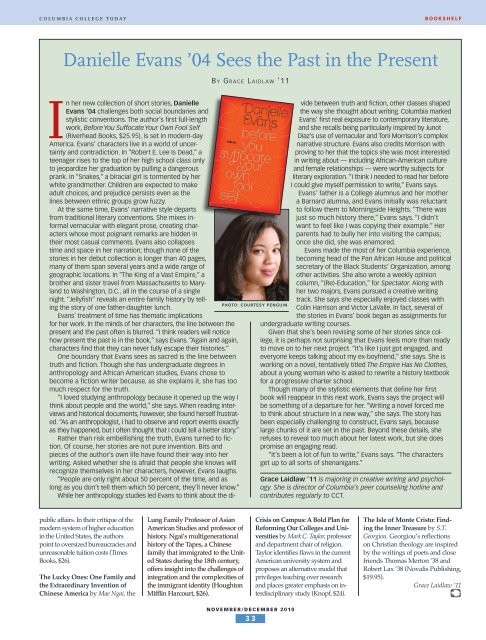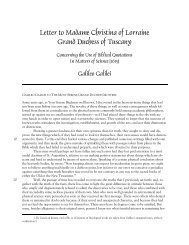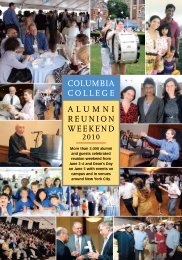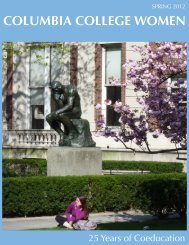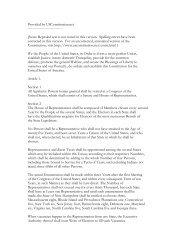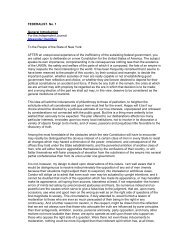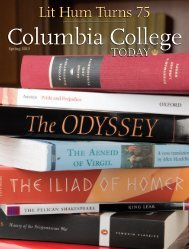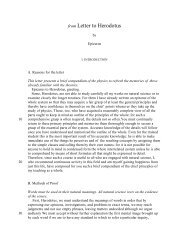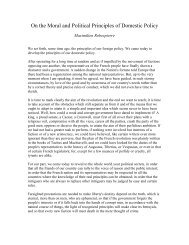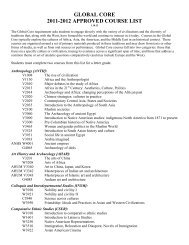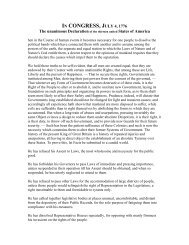Kyle Smith Takes the Helm in Levien Gym - Columbia College ...
Kyle Smith Takes the Helm in Levien Gym - Columbia College ...
Kyle Smith Takes the Helm in Levien Gym - Columbia College ...
Create successful ePaper yourself
Turn your PDF publications into a flip-book with our unique Google optimized e-Paper software.
<strong>Columbia</strong> CollEgE Today BOOKsHELF<br />
Danielle Evans ’04 Sees <strong>the</strong> Past <strong>in</strong> <strong>the</strong> Present<br />
<strong>in</strong> her new collection of short stories, Danielle<br />
Evans ’04 challenges both social boundaries and<br />
stylistic conventions. The author’s first full-length<br />
work, Before You Suffocate Your Own Fool Self<br />
(Riverhead Books, $25.95), is set <strong>in</strong> modern-day<br />
America. Evans’ characters live <strong>in</strong> a world of uncerta<strong>in</strong>ty<br />
and contradiction. In “Robert E. Lee Is Dead,” a<br />
teenager rises to <strong>the</strong> top of her high school class only<br />
to jeopardize her graduation by pull<strong>in</strong>g a dangerous<br />
prank. In “Snakes,” a biracial girl is tormented by her<br />
white grandmo<strong>the</strong>r. Children are expected to make<br />
adult choices, and prejudice persists even as <strong>the</strong><br />
l<strong>in</strong>es between ethnic groups grow fuzzy.<br />
At <strong>the</strong> same time, Evans’ narrative style departs<br />
from traditional literary conventions. She mixes <strong>in</strong>formal<br />
vernacular with elegant prose, creat<strong>in</strong>g characters<br />
whose most poignant remarks are hidden <strong>in</strong><br />
<strong>the</strong>ir most casual comments. Evans also collapses<br />
time and space <strong>in</strong> her narration; though none of <strong>the</strong><br />
stories <strong>in</strong> her debut collection is longer than 40 pages,<br />
many of <strong>the</strong>m span several years and a wide range of<br />
geographic locations. In “The K<strong>in</strong>g of a Vast Empire,” a<br />
bro<strong>the</strong>r and sister travel from Massachusetts to Maryland<br />
to Wash<strong>in</strong>gton, D.C., all <strong>in</strong> <strong>the</strong> course of a s<strong>in</strong>gle<br />
night. “Jellyfish” reveals an entire family history by tell<strong>in</strong>g<br />
<strong>the</strong> story of one fa<strong>the</strong>r-daughter lunch.<br />
Evans’ treatment of time has <strong>the</strong>matic implications<br />
for her work. In <strong>the</strong> m<strong>in</strong>ds of her characters, <strong>the</strong> l<strong>in</strong>e between <strong>the</strong><br />
present and <strong>the</strong> past often is blurred. “I th<strong>in</strong>k readers will notice<br />
how present <strong>the</strong> past is <strong>in</strong> <strong>the</strong> book,” says Evans. “Aga<strong>in</strong> and aga<strong>in</strong>,<br />
characters f<strong>in</strong>d that <strong>the</strong>y can never fully escape <strong>the</strong>ir histories.”<br />
One boundary that Evans sees as sacred is <strong>the</strong> l<strong>in</strong>e between<br />
truth and fiction. Though she has undergraduate degrees <strong>in</strong><br />
anthropology and African American studies, Evans chose to<br />
become a fiction writer because, as she expla<strong>in</strong>s it, she has too<br />
much respect for <strong>the</strong> truth.<br />
“I loved study<strong>in</strong>g anthropology because it opened up <strong>the</strong> way I<br />
th<strong>in</strong>k about people and <strong>the</strong> world,” she says. When read<strong>in</strong>g <strong>in</strong>terviews<br />
and historical documents, however, she found herself frustrated.<br />
“As an anthropologist, I had to observe and report events exactly<br />
as <strong>the</strong>y happened, but I often thought that I could tell a better story.”<br />
Ra<strong>the</strong>r than risk embellish<strong>in</strong>g <strong>the</strong> truth, Evans turned to fiction.<br />
Of course, her stories are not pure <strong>in</strong>vention. Bits and<br />
pieces of <strong>the</strong> author’s own life have found <strong>the</strong>ir way <strong>in</strong>to her<br />
writ<strong>in</strong>g. Asked whe<strong>the</strong>r she is afraid that people she knows will<br />
recognize <strong>the</strong>mselves <strong>in</strong> her characters, however, Evans laughs.<br />
“People are only right about 50 percent of <strong>the</strong> time, and as<br />
long as you don’t tell <strong>the</strong>m which 50 percent, <strong>the</strong>y’ll never know.”<br />
While her anthropology studies led Evans to th<strong>in</strong>k about <strong>the</strong> di-<br />
public affairs. In <strong>the</strong>ir critique of <strong>the</strong><br />
modern system of higher education<br />
<strong>in</strong> <strong>the</strong> United States, <strong>the</strong> authors<br />
po<strong>in</strong>t to oversized bureaucracies and<br />
unreasonable tuition costs (Times<br />
Books, $26).<br />
<strong>the</strong> lucky ones: one family and<br />
<strong>the</strong> Extraord<strong>in</strong>ary <strong>in</strong>vention of<br />
ch<strong>in</strong>ese america by Mae Ngai, <strong>the</strong><br />
Lung Family Professor of Asian<br />
American Studies and professor of<br />
history. Ngai’s multigenerational<br />
history of <strong>the</strong> Tapes, a Ch<strong>in</strong>ese<br />
family that immigrated to <strong>the</strong> United<br />
States dur<strong>in</strong>g <strong>the</strong> 18th century,<br />
offers <strong>in</strong>sight <strong>in</strong>to <strong>the</strong> challenges of<br />
<strong>in</strong>tegration and <strong>the</strong> complexities of<br />
<strong>the</strong> immigrant identity (Houghton<br />
Miffl<strong>in</strong> Harcourt, $26).<br />
B y gr a c e La i d L a W ’11<br />
PHOTO: COuRTEsY PENGuIN<br />
NOvEMBER/DECEMBER 2010<br />
33<br />
vide between truth and fiction, o<strong>the</strong>r classes shaped<br />
<strong>the</strong> way she thought about writ<strong>in</strong>g. <strong>Columbia</strong> marked<br />
Evans’ first real exposure to contemporary literature,<br />
and she recalls be<strong>in</strong>g particularly <strong>in</strong>spired by Junot<br />
Díaz’s use of vernacular and Toni Morrison’s complex<br />
narrative structure. Evans also credits Morrison with<br />
prov<strong>in</strong>g to her that <strong>the</strong> topics she was most <strong>in</strong>terested<br />
<strong>in</strong> writ<strong>in</strong>g about — <strong>in</strong>clud<strong>in</strong>g African-American culture<br />
and female relationships — were worthy subjects for<br />
literary exploration. “I th<strong>in</strong>k I needed to read her before<br />
I could give myself permission to write,” Evans says.<br />
Evans’ fa<strong>the</strong>r is a <strong>College</strong> alumnus and her mo<strong>the</strong>r<br />
a Barnard alumna, and Evans <strong>in</strong>itially was reluctant<br />
to follow <strong>the</strong>m to Morn<strong>in</strong>gside Heights. “There was<br />
just so much history <strong>the</strong>re,” Evans says. “I didn’t<br />
want to feel like I was copy<strong>in</strong>g <strong>the</strong>ir example.” Her<br />
parents had to bully her <strong>in</strong>to visit<strong>in</strong>g <strong>the</strong> campus;<br />
once she did, she was enamored.<br />
Evans made <strong>the</strong> most of her <strong>Columbia</strong> experience,<br />
becom<strong>in</strong>g head of <strong>the</strong> Pan African House and political<br />
secretary of <strong>the</strong> Black Students’ Organization, among<br />
o<strong>the</strong>r activities. She also wrote a weekly op<strong>in</strong>ion<br />
column, “(Re)-Education,” for Spectator. Along with<br />
her two majors, Evans pursued a creative writ<strong>in</strong>g<br />
track. She says she especially enjoyed classes with<br />
Col<strong>in</strong> Harrison and Victor LaValle. In fact, several of<br />
<strong>the</strong> stories <strong>in</strong> Evans’ book began as assignments for<br />
undergraduate writ<strong>in</strong>g courses.<br />
Given that she’s been revis<strong>in</strong>g some of her stories s<strong>in</strong>ce college,<br />
it is perhaps not surpris<strong>in</strong>g that Evans feels more than ready<br />
to move on to her next project. “It’s like I just got engaged, and<br />
everyone keeps talk<strong>in</strong>g about my ex-boyfriend,” she says. She is<br />
work<strong>in</strong>g on a novel, tentatively titled The Empire Has No Clo<strong>the</strong>s,<br />
about a young woman who is asked to rewrite a history textbook<br />
for a progressive charter school.<br />
Though many of <strong>the</strong> stylistic elements that def<strong>in</strong>e her first<br />
book will reappear <strong>in</strong> this next work, Evans says <strong>the</strong> project will<br />
be someth<strong>in</strong>g of a departure for her. “Writ<strong>in</strong>g a novel forced me<br />
to th<strong>in</strong>k about structure <strong>in</strong> a new way,” she says. The story has<br />
been especially challeng<strong>in</strong>g to construct, Evans says, because<br />
large chunks of it are set <strong>in</strong> <strong>the</strong> past. Beyond <strong>the</strong>se details, she<br />
refuses to reveal too much about her latest work, but she does<br />
promise an engag<strong>in</strong>g read.<br />
“It’s been a lot of fun to write,” Evans says. “The characters<br />
get up to all sorts of shenanigans.”<br />
Grace Laidlaw ’11 is major<strong>in</strong>g <strong>in</strong> creative writ<strong>in</strong>g and psychology.<br />
She is director of <strong>Columbia</strong>’s peer counsel<strong>in</strong>g hotl<strong>in</strong>e and<br />
contributes regularly to CCT.<br />
crisis on campus: a bold plan for<br />
reform<strong>in</strong>g our colleges and universities<br />
by Mark C. Taylor, professor<br />
and department chair of religion.<br />
Taylor identifies flaws <strong>in</strong> <strong>the</strong> current<br />
American university system and<br />
proposes an alternative model that<br />
privileges teach<strong>in</strong>g over research<br />
and places greater emphasis on <strong>in</strong>terdiscipl<strong>in</strong>ary<br />
study (Knopf, $24).<br />
<strong>the</strong> isle of Monte cristo: f<strong>in</strong>d<strong>in</strong>g<br />
<strong>the</strong> <strong>in</strong>ner treasure by S.T.<br />
Georgiou. Georgiou’s reflections<br />
on Christian <strong>the</strong>ology are <strong>in</strong>spired<br />
by <strong>the</strong> writ<strong>in</strong>gs of poets and close<br />
friends Thomas Merton ’38 and<br />
Robert Lax ’38 (Novalis Publish<strong>in</strong>g,<br />
$19.95).<br />
Grace Laidlaw ’11


